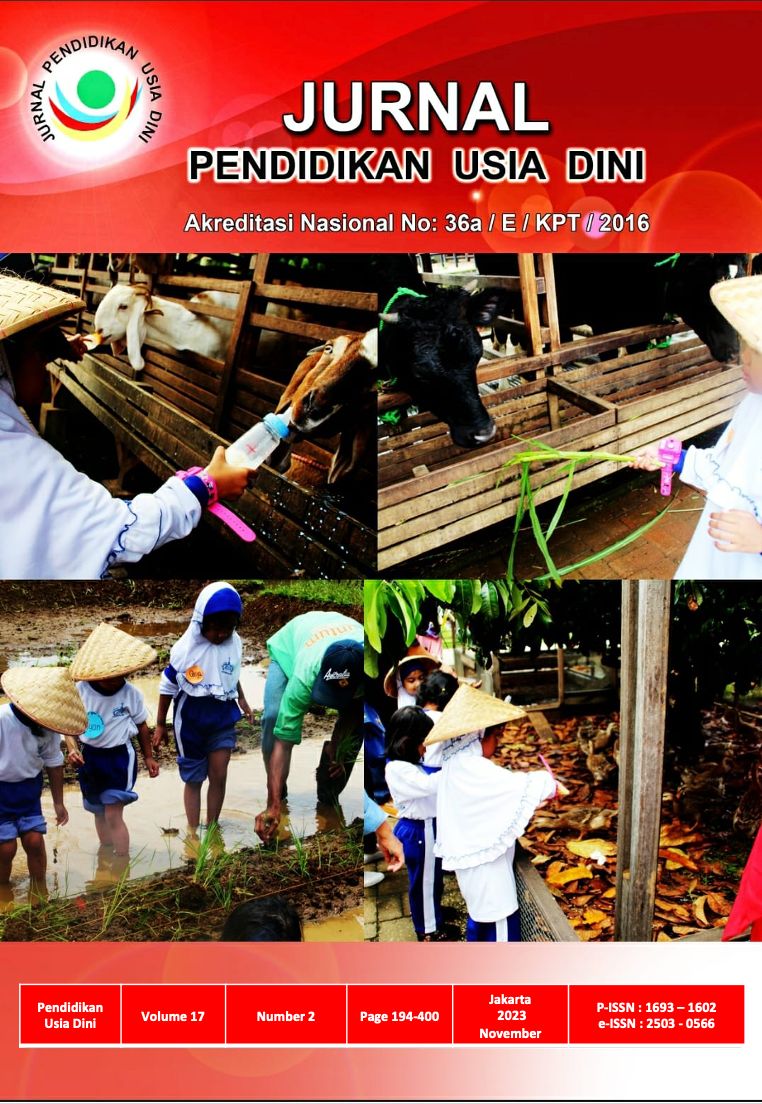Theory of Mind, Roles, and the Development of Emotion Regulation in Early Childhood
DOI:
https://doi.org/10.21009/JPUD.172.01Abstract
The ability to regulate children's emotions is the basis for psychosocial development which is the key to future success, and they can quickly adapt to other people or situations that may not always be comfortable for them. Theory of mind (ToM) is a construct used to describe the ability to interpret other people's mental states, which then develops into the ability to empathize. This study examines how the theory of mind contributes to the development of emotion regulation in children aged 4, 5, and 6 years. This research used a quasi-experimental design to find the effect of ToM stimulation on children's emotional regulation. 109 respondents were selected using a purposive sampling technique. The scales used in this research are the PreBers scale to examine children's emotional regulation and the ToM scale. The research results showed that the influence of ToM development on children's emotional regulation was 52.4%. The results of this research highlight that the better the child acquires a Theory of Mind, the better the development of the child's emotional regulation. Furthermore, these findings are significant for early childhood education providers to develop programs to optimize ToM acquisition from childhood.
Keywords: theory of mind, empathy, emotion regulation, children aged 4, 5, and 6 years
References:
Benita, M., Levkovitz, T., & Roth, G. (2017). Integrative emotion regulation predicts adolescents’ prosocial behavior through the mediation of empathy. Learning and Instruction, 50, 14–20. https://doi.org/10.1016/j.learninstruc.2016.11.004
Cress, C. J., Synhorst, L., Epstein, M. H., & Allen, E. (2012). Confirmatory factor analysis of the preschool behavioral and emotional rating scale (PreBERS) with preschool children with disabilities. Assessment for Effective Intervention, 37(4), 203–211. https://doi.org/10.1177/1534508411433499
Cress, C., Lambert, M. C., & Epstein, M. H. (2016). Factor Analysis of the Preschool Behavioral and Emotional Rating Scale for Children in Head Start Programs. Journal of Psychoeducational Assessment, 34(5), 473–486. https://doi.org/10.1177/0734282915617630
Diane E.Papalia; Gabriella Martorell. (2014). Experience Human Development (13th ed.). McGraw Hill-Education.
Dunfield, K. A., & Kuhlmeier, V. A. (2013). Classifying prosocial behavior: Children’s responses to instrumental need, emotional distress, and material desire. Child Development, 84(5), 1766–1776. https://doi.org/10.1111/cdev.12075
Eisenberg, N., Fabes, R. A., & Spinrad, T. L. (2007). Prososial Development. Handbook of Child Psychology, 73.
Fitzpatrick, P., Frazier, J. A., Cochran, D., Mitchell, T., Coleman, C., & Schmidt, R. C. (2018). Relationship Between Theory of Mind, Emotion Recognition, and Social Synchrony in Adolescents With and Without Autism. Frontiers in Psychology, 9(July), 1–13. https://doi.org/10.3389/fpsyg.2018.01337
Glenwright, M., & Pexman, P. M. (2010). Development of children’s ability to distinguish sarcasm and verbal irony. Journal of Child Language, 37(2), 429–451. https://doi.org/10.1017/S0305000909009520
Graham, A., & Fitzgerald, R. (2011). Supporting children’s social and emotional well-being: Does “having a say” matter? Children and Society, 25(6), 447–457. https://doi.org/10.1111/j.1099-0860.2010.00295.x
Hum, K., & Lewis, M. (2013). Emotion Regulation in Children. Handbook of Self-Regulatory Processes in …, 33(April), 102–112. http://books.google.com/books?hl=en&lr=&id=o9DG7crxtZoC&oi=fnd&pg=PA173&dq=Emotion+Regulation+in+Children+With&ots=Lh-WsDVhYR&sig=9M0LvXTiIxBAP85dfTvmEIvqJWA
Imuta, K., Henry, J. D., Slaughter, V., & Ruffman, T. (2016). Supplemental Material for Theory of Mind and Prosocial Behavior in Childhood: A Meta-Analytic Review. Developmental Psychology, 52(8), 1192–1205. https://doi.org/10.1037/dev0000140.supp
Kuntoro, I. A., Risnawati, E., & Collier-Baker, E. (2019). The development of mental time travel in Indonesian children. Diversity in Unity: Perspectives from Psychology and Behavioral Sciences, 91–98. https://doi.org/10.1201/9781315225302-12
Lane, J. D., Wellman, H. M., Olson, S. L., LaBounty, J., & Kerr, D. C. R. (2010). Theory of mind and emotional understanding predict moral development in early childhood. British Journal of Developmental Psychology, 28(4), 871–889. https://doi.org/10.1348/026151009X483056
Lee, K., Sidhu, D. M., & Pexman, P. M. (2021). Teaching sarcasm: Evaluating metapragmatic training for typically developing children. Canadian Journal of Experimental Psychology, 75(2), 139–145. https://doi.org/10.1037/cep0000228
Lei, Y., Wang, Y., Wang, C., Wang, J., Lou, Y., & Li, H. (2019). Taking familiar others’ perspectives to regulate our own emotion: An event-related potential study. Frontiers in Psychology, 10(JUN), 1–9. https://doi.org/10.3389/fpsyg.2019.01419
Lewis, A. (2019). Examining the concept of well-being and early childhood: Adopting multi-disciplinary perspectives. Journal of Early Childhood Research, 17(4), 294–308. https://doi.org/10.1177/1476718X19860553
Meyebovsky, M. M., Tabullo, Á. J., & García, C. S. (2021). Associations between Theory of Mind and Emotion Regulation in Argentinean Adults. Current Psychology, 40(12), 6118–6131. https://doi.org/10.1007/s12144-019-00539-9
Mizokawa, Ai; Koyasu, M., & Mizokawa, A. (1999). Children ’ understanding of hidden emotion , theory of mind , and peer relationship Method Participants. 2025–2030.
Nyklíček, I., Zeelenberg, M., & Vingerhoets, A. (2011). Emotion regulation and well-being. In Emotion Regulation and Well-Being (Issue January 2011). https://doi.org/10.1007/978-1-4419-6953-8
Risnawati, E., Anggraika, I., & Collier-baker, E. (2015). Kontribusi Perolehan Theory of mind terhadap Perkembangan mental Time Travel pada Anak Usia 3-5 tahun. 4(1), 37–39.
Shahaeian, A., Peterson, C. C., Slaughter, V., & Wellman, H. M. (2011). Culture and the Sequence of Steps in Theory of Mind Development. Developmental Psychology, 47(5), 1239–1247. https://doi.org/10.1037/a0023899
Shukla, P., & Rishi, P. (2014). A Corelational Study of Psychosocial & Spiritual Well Being and Death Anxiety among Advanced Stage Cancer Patients. American Journal of Applied Psychology, 2(3), 59–65. https://doi.org/10.12691/ajap-2-3-1
Slaughter, V., Dennis, M. J., & Pritchard, M. (2002). Theory of mind and peer acceptance in preschool children. British Journal of Developmental Psychology, 20(4), 545–564. https://doi.org/10.1348/026151002760390945
Wellman, H. M., & Liu, D. (2004). Scaling of theory-of-mind tasks. Child Development, 75(2), 523–541. https://doi.org/10.1111/j.1467-8624.2004.00691.x
Downloads
Published
How to Cite
Issue
Section
License
JURNAL PENDIDIKAN USIA DINI work is licensed under a Creative Commons Attribution 4.0 International License. (http://creativecommons.org/licenses/by/4.0/)





